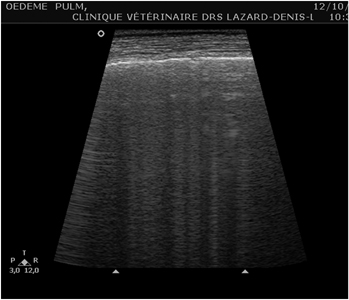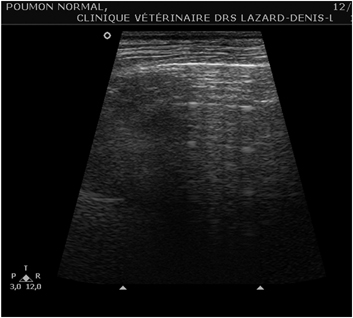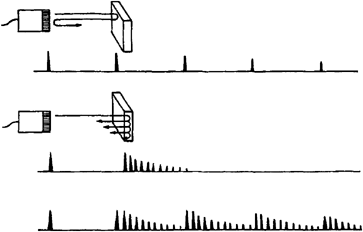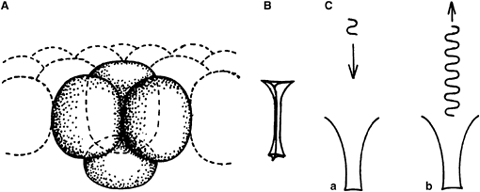LUNG RING-DOWN ARTIFACT AS A SIGN OF PULMONARY ALVEOLAR-INTERSTITIAL DISEASE
Abstract
Three dogs with presumptive cardiogenic pulmonary edema underwent a thoracic ultrasonographic examination. Multiple ring-down artifacts involving both sides of the thorax emanating from the pleural–lung interface were detected. When clinical and radiographic signs of pulmonary edema were resolved, ring-down artifacts were not observed. The ring-down artifact may be a useful diagnostic sign for screening the lung of animals with acute respiratory distress where radiographs are not feasible.
Introduction
The ring-down ultrasonographic artifact is commonly associated with gas and liquid collections within the gastrointestinal tract. The ring-down artifact has the appearance of vertical hyperechoic lines spreading to the deep portion of the image. In humans, the ring-down artifact is also seen associated with alveolar-interstitial disease. Little is known about the association between the ring-down artifact and lung disease in veterinary medicine. Because of the limitations created by normal aerated lung, ultrasound assessment of pulmonary disease in small animal patients is generally limited to peripheral masses, pneumonia, or atelectasis. In this report, we present our experience using gray-scale ultrasound to evaluate the abnormal pleural–lung interface in dogs with cardiogenic pulmonary edema. A review of the physical basis responsible for the ring-down artifact is also presented.
Patient Evaluation
Dog 1
A mature Cavalier King Charles spaniel dog had chronic myxomatous mitral valve degeneration and was being treated with conventional drugs. Clinical signs of left heart failure developed. Because of the severity of respiratory distress, the dog was placed in an oxygen cage and given repeated intravenous administrations of furosemide. A cursory thoracic sonographic examination was performed using minimal restraint and a high resolution 3–12 MHz linear array transducer* centered at 7.5 MHz without harmonics. Longitudinal and transverse scans of the right and left lateral thoracic walls were conducted in a standing position. A large number of thick, continuous, nonattenuating, vertical hyperechoic lines originating at the pleural–lung interface and spreading to the deep portion of the image were seen. These lines represented ring-down artifacts (Fig. 1; supplementary material Video 1). Twelve hours after oxygen and furosemide therapy, the dog became eupneic and thoracic radiographs confirmed a multifocal interstitial–alveolar pattern. Ring-down artifacts were still detectable in ultrasound scans of the thorax. Ultrasonographic and radiographic abnormalities, compatible with cardiogenic pulmonary edema, subsequently disappeared after 24 h of diuretic therapy.

Sagittal (dorsal to the left) intercostal image of a dog with cardiogenic pulmonary edema. The thin, smooth echogenic horizontal line represents the normal pleural–lung interface. The area beneath the lung surface is composed of numerous echogenic vertical streaks spreading down to the deep portion of the image; these represent ring-down artifacts. These artifacts are best seen under real-time conditions, because their appearance is often less striking on frozen images. See supplementary material video 1 available with the online version of this paper.
Dog 2
A mature Bichon Frise dog had a cough, cyanosis, and lethargy that progressed to syncope during normal walking. A heart murmur had been detected 2 months previously, but the dog had no history of cough, dyspnea, or exercise intolerance before the onset of clinical signs and was receiving no medication. There was a loud systolic heart murmur and cyanosis. In thoracic radiographs there was a hazy interstitial pattern in the caudodorsal lung field (Fig. 2A). Upon ultrasonographic examination of the right and left thorax using the previously described probe and settings, there were numerous vertical hyperechoic lines arising from the pleural–lung interface and extending to the deep portion of the image, representing ring-down artifacts (Fig. 2B). The dog was treated for left heart failure and stabililized after a few hours. Three days after initiation of treatment, thoracic radiographs were considered normal and upon sonographic examination of both sides of the thorax there were a few horizontal, regularly spaced hyperechoic lines. The distance between the consecutives lines was the same as the distance between the transducer and the hyperechoic pleural–lung interface. In the deepest portion of the image, the horizontal lines progressively disappeared. There were no hyperechoic vertical lines (Fig. 2C).

(A) Right lateral radiograph of a dog with cardiogenic pulmonary edema. Note the hazy interstitial pattern in the caudodorsal lung. (B) Sagittal (dorsal to the left) intercostal ultrasonographic image; note the numerous ring-down artifacts. (C) Ultrasound image acquired after clinical and radiographic signs of pulmonary edema had resolved. Note the lack of ring-down artifacts.
Dog 3
A mature Yorkshire terrier suffered from a tracheal collapse and also had a 4/6 systolic heart murmur. Cardiac ultrasound confirmed severely left atrial dilation and mitral regurgitation. Upon ultrasonographic examination of the right and left thorax using the previously described probe and settings, there were numerous vertical hyperechoic lines arising from the pleural–lung interface and extending to the deep portion of the image, representing ring-down artifacts. Thoracic radiographs were characterized by a hazy interstitial pattern in the caudodorsal lung field. Diuretic therapy was initiated and the dog was examined 8 days later by which time the cough had markedly improved. Upon ultrasonographic examination of the thorax, there were normal reverberation artifacts but no ring-down artifact. Thoracic radiographs were normal except for cervical tracheal collapse.
Discussion
In normal humans1 and small animals,2,3 the costal portion of the parietal pleura, the pulmonary pleura, and the interface of the pleura with aerated lung appear as a highly echogenic band immediately below the layered image of the thoracic wall muscles. Deep to this echogenic line, different normal ultrasonographic patterns have been recognized (Fig. 3; supplementary material Video 2). The first consists of repetition of equally spaced, horizontal, parallel echogenic lines, called the reverberation or repetition artifact. The second is a roughly vertical, narrow-based artifact spreading to the deep edge of the image known as the ring-down or comet-tail artifact. The terms “reverberation” and “repetition” are often incorrectly employed to describe the same phenomenon.2,4 Similarly, the term “comet-tail” is often used to describe, both “comet-tail” and “ring-down” artifacts.5–7 Strictly speaking, three different kinds of artifact exist, characterized by three specific underlying mechanisms. These are1 repetition,2 reverberation or comet-tail artifacts, and3 ring-down artifacts. Unfortunately, a great majority of the comet-tail artifacts described in the literature are in fact ring-down artifacts.8–10

Sagittal (dorsal to the left) intercostal image of the thorax of a normal dog. The thin smooth echogenic line represents the normal pleural–lung interface. Repetition of this horizontal line is seen at least twice in the deeper portion of the thorax. In the right part of the image, vertical streaks attenuating in the deepest portions of the image and composed of linear echoes, representing comet-tail artifacts, are visualized. See supplementary material video 2 available with the online version of this paper.
Repetition artifacts appear when the ultrasound beam meets an interface composed of very different acoustic impedances (tissue–air interface). Virtually all of the ultrasound energy is reflected back to the transducer, then propagated towards the target, insonating it a second time. If the energy from the ultrasound beam remained sufficient, a third emission draws out a third echo from the original source. And so on, n repetition echoes can be seen. The energy of the beam, reflected multiple times between transducer and target, decreases progressively, and the repetition echoes are of decreasing intensity with depth. In this instance, the extra distance traveled is a multiple of that between the interface and the transducer.
Reverberation or comet-tail artifacts are composed of extra echoes that are not a multiple of the transducer–interface distance. Comet-tail artifacts appear when the ultrasonic beam is trapped in an environment limited in surface area and in depth by two or more other environments of very different acoustic impedances. In this situation, multiple internal reflections of the sound beam within the environment account for additional echoes appearing beyond the superficial interface. Similar to repetition echoes, the energy of the ultrasound beam decreases in successive paths, and deep horizontal echoes are of decreasing intensity (Fig. 4).

Repetition and reverberation (comet-tail) artifacts. The upper diagram demonstrates the mechanism responsible for the repetition artifact. Part of the ultrasound energy is reflected back to the transducer, and then propagates again towards the target to insonate it a second time, and so on, n repetition echoes can be drawn out. The extra distance traveled is a multiple of that between the interface and the transducer. The middle diagram shows the internal reverberations within the object. These extra echoes (comet-tail) are not a multiple of the transducer-interface distance. The lower diagram demonstrates the simultaneous occurrence of these two processes. Reprinted with permission from the Journal of Ultrasound in Medicine11, published by the American Institute of Ultrasound in Medicine.
Ring-down artifacts have a different mechanism despite often being confused with comet-tail artifacts in the literature.11,12 Ring-down artifacts lack distinct repetitive linear interfaces, and are drawn out over a greater depth. The mechanism of their formation thought to be specific, and unrelated to reverberation.12 Ring-down artifacts have been shown experimentally to originate from the center of a complex gas bubble layer (bubble tetrahedron), trapping within it a bugle-shaped fluid collection.12 According to this theory, the fluid bugle, struck by the ultrasound pulse, acts as an oscillator, becoming a continuous secondary source of ultrasound waves7,12,13 (Fig. 5).

(A) Diagram of a bubble tetrahedron formed by two layers of bubbles. (B) Diagram of a bugle-shaped fluid collection formed within a bubble tetrahedron. (C) The fluid bugle, struck by the ultrasound pulse, acts as an oscillator, becoming a continuous secondary source of ultrasonic waves. Reprinted with permission from the Journal of Ultrasound in Medicine12, published by the American Institute of Ultrasound in Medicine.
Ring-down artifacts have been observed in healthy humans. However, they can normally be found only in a very small quantity over the lung surface, and more frequently in the last intercostal spaces when the patient is examined upright.5,8 When observed in large quantity, ring-down artifacts have been particularly useful in the ultrasonographic diagnosis of alveolar-interstitial disease, especially in the emergency department where thoracic radiographs performed at the bedside may be technically deficient.6–8,10,14,15 Numerous ring-down artifacts are considered an accurate lung ultrasound sign for the presence of alveolar-interstitial disease in humans. The skill to recognize the artifact was easily acquired by ultrasonographers, and reproducibility was good; interobserver variability was <5% in the interpretation of a single image.8 However, the examination is not specific for a particular disease process. Pulmonary edema, pleuritis, pulmonary fibrosis, interstitial pneumonia, and pulmonary contusion, which are all characterized by a thickening of either the pleura or the interlobular septa, can lead to ring-down artifacts.
In the particular context of pulmonary edema in humans, the finding of ring-down artifacts can supply quantitative information. The association between radiographic signs of pulmonary edema and wedge pressure is poor. Radiographic signs of pulmonary edema were absent in 53% of patients with mild to moderately elevated pulmonary capillary wedge pressure and in 39% of patients with markedly elevated pulmonary capillary wedge pressure.15 Pulmonary edema with high wedge pressure can thus coexist without radiographic abnormalities. Alternatively, a positive linear correlation between ring-down artifact score and wedge pressure has been described.6 Moreover, a correlation between lung ring-down artifact score and extravascular lung water content has also been found.6,7 Thus, the presence of lung ultrasound ring-down artifacts and their number allows a crude quantification of the amount of extravascular lung water. Furthermore, ultrasound is sufficiently sensitive to detect pulmonary interstitial edema even before it becomes clinically apparent.6,7
Based on our findings, ultrasound examination of the pleural–lung interface and the quantification of ring-down artifacts might provide valuable information. A more detailed comparison between the presence and quantification of lung ring-down artifacts and the radiographic appearance of the lung is needed before the real value of thoracic sonography in patients suspected of having interstitial–alveolar disease is known. The ultimate test would be to compare results from radiographic and ultrasonographic examinations with a reference computed tomography examination.
Footnotes
ACKNOWLEDGMENTS
The authors wish to thank Tanguy Bléhaut, a third year student at Royal Veterinary College, London, UK, for his help during the preparation of the manuscript.




